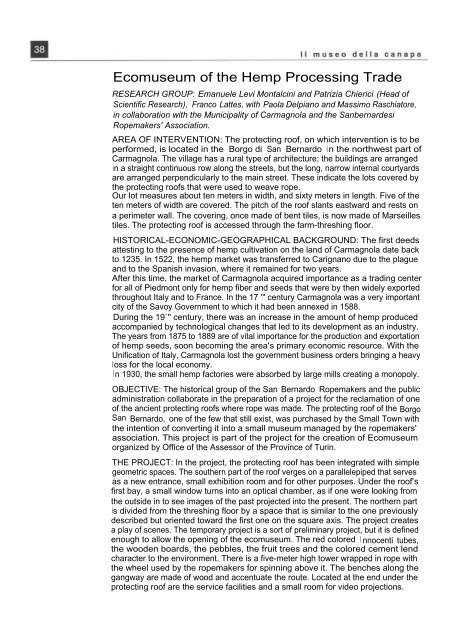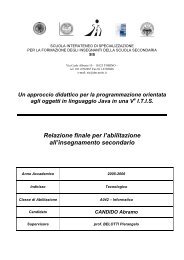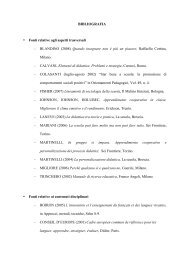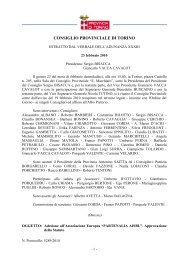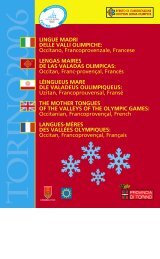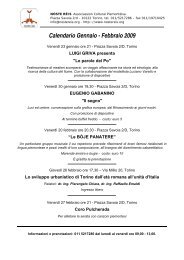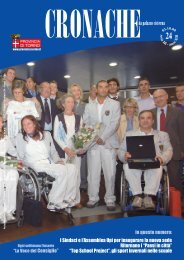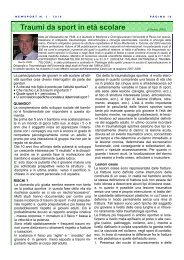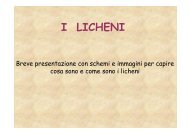Ricerche e proposte per il Progetto Cultura Materiale - Provincia di ...
Ricerche e proposte per il Progetto Cultura Materiale - Provincia di ...
Ricerche e proposte per il Progetto Cultura Materiale - Provincia di ...
Create successful ePaper yourself
Turn your PDF publications into a flip-book with our unique Google optimized e-Paper software.
Ecomuseum of the Hemp Processing Trade<br />
RESEARCH GROUP: Emanuele Levi Montalcini and Patrizia Chierici (Head of<br />
Scientific Research), Franco Lattes, with Paola Delpiano and Massimo Raschiatore,<br />
in collaboration with the Municipality of Carmagnola and the Sanbernardesi<br />
Ropemakers' Association.<br />
AREA OF INTERVENTION: The protecting roof, on which intervention is to be<br />
<strong>per</strong>formed, is located in the Borgo <strong>di</strong> San Bernardo in the northwest part of<br />
Carmagnola. The v<strong>il</strong>lage has a rural type of architecture; the bu<strong>il</strong><strong>di</strong>ngs are arranged<br />
in a straight continuous row along the streets, but the long, narrow internal courtyards<br />
are arranged <strong>per</strong>pen<strong>di</strong>cularly to the main street. These in<strong>di</strong>cate the lots covered by<br />
the protecting roofs that were used to weave rope.<br />
Our lot measures about ten meters in width, and sixty meters in length. Five of the<br />
ten meters of width are covered. The pitch of the roof slants eastward and rests on<br />
a <strong>per</strong>imeter wall. The covering, once made of bent t<strong>il</strong>es, is now made of Marse<strong>il</strong>les<br />
t<strong>il</strong>es. The protecting roof is accessed through the farm-threshing floor.<br />
HISTORICAL-ECONOMIC-GEOGRAPHICAL BACKGROUND: The first deeds<br />
attesting to the presence of hemp cultivation on the land of Carmagnola date back<br />
to 1235. In 1522, the hemp market was transferred to Carignano due to the plague<br />
and to the Spanish invasion, where it remained for two years.<br />
After this time, the market of Carmagnola acquired importance as a tra<strong>di</strong>ng center<br />
for all of Piedmont only for hemp fiber and seeds that were by then widely exported<br />
throughout Italy and to France. In the 17 '" century Carmagnola was a very important<br />
city of the Savoy Government to which it had been annexed in 1588.<br />
During the 19`" century, there was an increase in the amount of hemp produced<br />
accompanied by technological changes that led to its development as an industry.<br />
The years from 1875 to 1889 are of vital importance for the production and exportation<br />
of hemp seeds, soon becoming the area's primary economic resource. With the<br />
Unification of Italy, Carmagnola lost the government business orders bringing a heavy<br />
loss for the local economy.<br />
In 1930, the small hemp factories were absorbed by large m<strong>il</strong>ls creating a monopoly.<br />
OBJECTIVE: The historical group of the San Bernardo Ropemakers and the public<br />
administration collaborate in the preparation of a project for the reclamation of one<br />
of the ancient protecting roofs where rope was made. The protecting roof of the Borgo<br />
San Bernardo, one of the few that st<strong>il</strong>l exist, was purchased by the Small Town with<br />
the intention of converting it into a small museum managed by the ropemakers'<br />
association. This project is part of the project for the creation of Ecomuseum<br />
organized by Office of the Assessor of the Province of Turin.<br />
THE PROJECT: In the project, the protecting roof has been integrated with simple<br />
geometric spaces. The southern part of the roof verges on a parallelepiped that serves<br />
as a new entrance, small exhibition room and for other purposes. Under the roof's<br />
first bay, a small window turns into an optical chamber, as if one were looking from<br />
the outside in to see images of the past projected into the present. The northern part<br />
is <strong>di</strong>vided from the threshing floor by a space that is sim<strong>il</strong>ar to the one previously<br />
described but oriented toward the first one on the square axis. The project creates<br />
a play of scenes. The temporary project is a sort of preliminary project, but it is defined<br />
enough to allow the opening of the ecomuseum. The red colored I nnocenti tubes,<br />
the wooden boards, the pebbles, the fruit trees and the colored cement lend<br />
character to the environment. There is a five-meter high tower wrapped in rope with<br />
the wheel used by the ropemakers for spinning above it. The benches along the<br />
gangway are made of wood and accentuate the route. Located at the end under the<br />
protecting roof are the service fac<strong>il</strong>ities and a small room for video projections.


